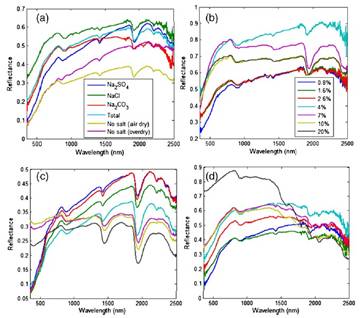Modeling Salinity Effects on Soil Reflectance under Various Moisture Conditions and Its Inverse Application
2012-04-05
Soil salinization is one of the most common land degradation processes in arid and semi-arid regions and seriously damages ecosystem functions. Early identification of salt-affected areas and monitoring are essential for sustainable agricultural management, which are vital for making timely and proper decisions for halting soil salinization. Compared with conventional techniques for measuring soil salinization, remote sensing has many advantages on the contexts of high temporal sampling frequency and rapid nondestructive characterization of a wide range of materials.
Many studies have shown that hyperspectral data can be used to quantify characteristics of saline soils at various scales. Although hyperspectral remote sensing has been widely applied already, few studies have specifically addressed the effect of soil moisture to salt estimation from reflectance, especially at low and moderately affected areas. As a result, a moisture resistant estimation method is of necessary for early detection and quick monitoring of soil salinity in the large spatial scale, viewing from the large spatial and temporal variations of soil moisture, especially in dry lands.
Following the previous works, Prof. WANG Quan, LI Pingheng and CHEN Xi developed an exponent reflectance model to estimate soil salt contents inversely under various soil moisture conditions, based on a control laboratory experiment on the two factors (soil salinity and soil moisture) to soil reflectance.
To achieve this objective, main soil salt types (Na2SO4, NaCl, Na2CO3) with wide soil salinity (0 to 20%) and soil moisture (1.75% to 20%) levels (in weight base) from Western China were examined for their effects on soil reflectance through a model based approach. Moisture resistant but salt sensitive bands of reflected spectra have been identified for the model before being applied to inversely estimate soil salt content. Sensitive bands for Na2SO4 type of salt affected soils were identified as from 1920 to 2230 nm, and 1970 to 2450 nm for NaCl, 350 to 400 nm for Na2CO3 type of salt affected soils, respectively. The sensitive bands focused on ranged from 1950 to 2450 nm when all data were considered when ignoring salt types. The model was then applied to inversely estimate soil salt contents. High R2 of 0.87, 0.79, and 0.66, and low mean relative error (MRE) of 16.42%, 21.17%, and 27.16%; have been obtained for NaCl, Na2SO4 and Na2CO3, respectively. Performance of the inverse model dropped but remained significant when ignoring salt types with an R2 of 0.56 and a MRE of 33.25%. The approach proposed in this study should thus provide a new direction for estimating salinity from reflectance under various soil moisture conditions and should have wide applications in future monitoring of soil salinization.
This research was supported by the 100 Talents Program of The Chinese Academy of Sciences, the NSFC project (No. 41071238), and the JSPS project (No. 21403001). The main finding has been published on Geoderma, 2012, 170(15): 103-111. The paper is also archived at http://www.sciencedirect.com/science/article/pii/S0016706111003004.

Fig. 1 Effects of salts on air-dried soil reflectance spectra: (a) different salt types (averaged spectra from all seven levels of salt contents); (b) change of reflectance spectra with different levels of Na2SO4 contents; (c) change of reflectance spectra with different levels of NaCl contents; (d) change of reflectance spectra with different levels of Na2CO3 contents.



